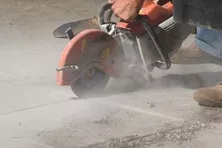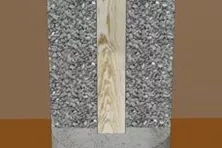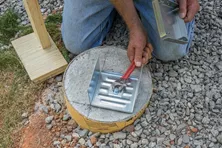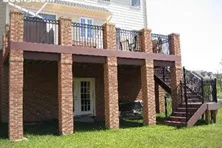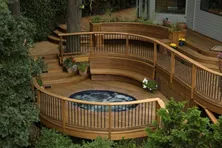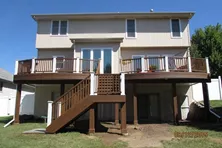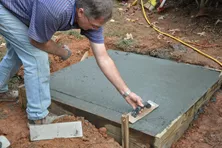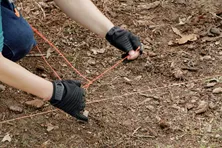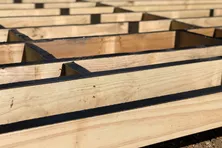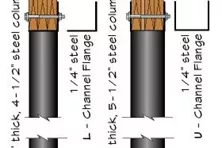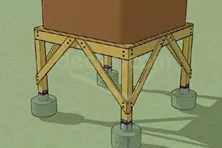How to Prevent Sagging & Sinking Decks
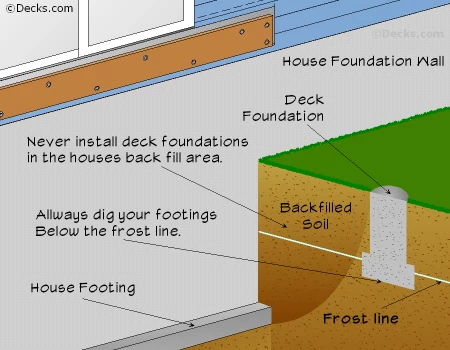
Before you dig your frost footings, you will want to make sure the soil is properly compacted to support the deck load. Often when new houses are built, the process of digging the foundation disrupts the soil and leaves the yard unsettled. This means the entire yard will slowly drop in elevation relative to the house.
It is not uncommon for this to cause patios and driveways to crack. Likewise, if you anchor a deck to footings that are built on soil that is not properly compacted, your deck will probably sink. Needless to say, this is something you want to avoid. If you suspect your soil is unsettled, you will either have to wait for the yard to settle or dig the footings to a depth where the ground is compact. Certain kinds of soils are more problematic than others. Clay soils are particularly prone to shrinking and swelling. If you live in a new house, you may want to talk to your builder or local building inspections department to see if they have any information or suggestions. You can mark the level of the yard as it meets the house where you will be building your deck and observe it over a couple of months to see if you notice any change. If you have reason to believe settling may cause you problems, you may consider hiring a soil engineer to assess the situation, but this will result in an added cost to your project.
Cutting a Concrete Pad
Learn how to use a concrete saw to cut a hole in a patio slab to install a deck footing.
Buried Post
Learn how to install a concrete deck footing with a buried treated support post as an alternative to a solid pier foundation.
How many footings do I need?
Learn how to determine the number of footings and support posts you need for your deck when designing your deck frame.
How to Decorate Deck Support Columns
Browse some examples of decorative deck support posts for tall decks.
Building a Round or Curved Deck
Learn how to build a curved deck using standard wood-framing materials. Composite decking material is more flexible for curved decks than wood.
How to Install Deck Post Wraps and Sleeves
Learn how to install trim or post sleeves over your pressure-treated support posts for a cleaner finish and to protect the material from checking.
More Helpful Resources
Explore Articles by Topic

Footings
Information related to installing frost footings for decks

Framing
Learn structural framing methods

Decking
Learn about wood and composite decking materials

Stairs
An in-depth look at the complex issue of how to build stairs

Railings
How to install guardrails and handrails to meet IRC code

Features
An overview on water drainage, benches, planters and lights

Design
The basics of deck design

Planning
Learn about permits and working with contractors

Porches & Patios
Build a covered deck to enjoy all seasons

Ledger
Proper attachment techniques

Care
Maintain your deck to maintain your investment

Materials
An overview on water drainage, benches, planters and lights
How many footings do I need?
Learn how to determine the number of footings and support posts you need for your deck when designing your deck frame.
Working With Concrete
Learn tips from the pros on how to mix and pour concrete for deck footings.
Layout Deck Foundations
Learn how to lay out your deck footings accurately using triangulation with our step-by-step instructions.
Why is Joist Protection so Important for Your Deck?
If you’ve ever seen a piece of wood left out in the weather for any period of time, you know what happens: decay. Whether through wet rot, insect damage, or mildew, the fibers begin to break down.
How to Use Steel Metal Deck Support Posts and Columns
Steel deck posts with base plates can be used as an alternative to wood posts for supporting your deck.
Building Your Deck For A Hot Tub
Learn how to build a deck to properly support a hot tub or spa. Hot tubs are very heavy. Never place a hot tub on a deck that wasn't designed for the additional load.
Explore Articles by Topic

Footings
Information related to installing frost footings for decks

Framing
Learn structural framing methods

Decking
Learn about wood and composite decking materials

Stairs
An in-depth look at the complex issue of how to build stairs

Railings
How to install guardrails and handrails to meet IRC code

Features
An overview on water drainage, benches, planters and lights

Design
The basics of deck design

Planning
Learn about permits and working with contractors

Porches & Patios
Build a covered deck to enjoy all seasons

Ledger
Proper attachment techniques

Care
Maintain your deck to maintain your investment

Materials
An overview on water drainage, benches, planters and lights




